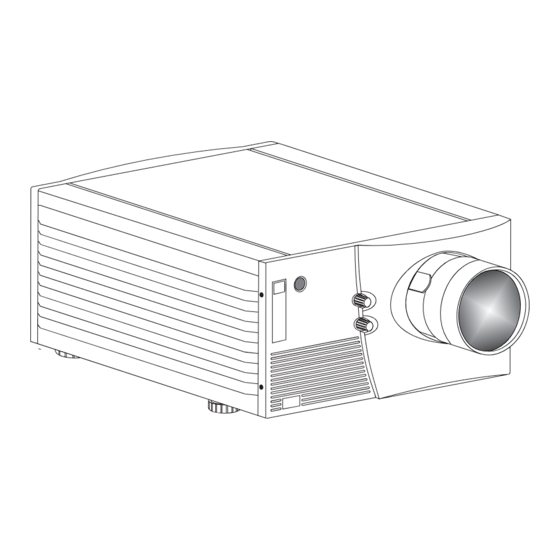
Table of Contents
Advertisement
1
2
3
4
5
6
Appendices
NOTE: Due to continuing research, all information in this manual is subject to change without notice
54-017142-06P Software Version 2.1 (08/02)
Table of Contents
Section
Contents
1.1
The Projectors...................................................................................................1-1
1.2
Components ......................................................................................................1-2
1.3
Purchase Record and Servicing.........................................................................1-2
2.1
Quick Setup.......................................................................................................2-1
2.2
Installation Considerations................................................................................2-3
2.3
Projector Position and Mounting ......................................................................2-8
2.4
Source Connections ........................................................................................2-13
2.5
Power Connection...........................................................................................2-20
2.6
Operating Orientation .....................................................................................2-20
2.7
Leveling ..........................................................................................................2-21
2.8
Zoom, Focus & Lens Offset ............................................................................2-21
2.9
Serial Port Connections...................................................................................2-24
2.10
Keypad Protocols and Conversion ..................................................................2-30
3.1
Overview...........................................................................................................3-1
3.2
Projector Basics ................................................................................................3-1
3.3
Using the Keypad..............................................................................................3-4
3.4
Navigating the Menus .....................................................................................3-13
3.5
Using Inputs and Channels..............................................................................3-17
3.6
Adjusting the Image ........................................................................................3-22
3.7
Configuring System Parameters ......................................................................3-39
3.8
Working With the Lamp .................................................................................3-46
3.9
Projector Status...............................................................................................3-49
3.10
3D Images .......................................................................................................3-50
3.11
Using Multiple Projectors ...............................................................................3-58
3.12
Error Conditions .............................................................................................3-69
4.1
Warnings and Guidelines ..................................................................................4-1
4.2
Cleaning ............................................................................................................4-3
4.3
Replacing Keypad Batteries..............................................................................4-3
4.4
Replacing the Lamp and Filter ..........................................................................4-4
4.5
Replacing the Lens............................................................................................4-9
4.6
Troubleshooting ..............................................................................................4-12
5.1
Specifications....................................................................................................5-1
A
Glossary ...........................................................................................................A-1
B
Keypad Reference ........................................................................................... B-1
C
Menu Tree........................................................................................................ C-1
D
Serial Communication Cables ..........................................................................D-1
E
Throw Distance................................................................................................ E-1
F
Optional Input Modules ................................................................................... F-1
User's Manual
Page
iii
Advertisement
Table of Contents


Need help?
Do you have a question about the 2000 and is the answer not in the manual?
Questions and answers